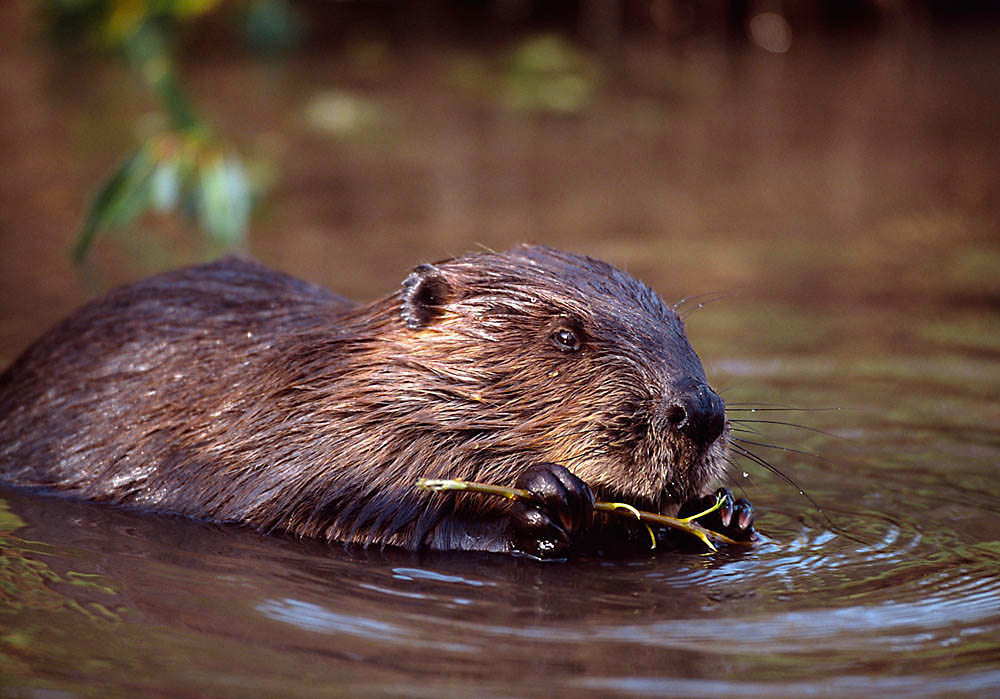 With thanks to Richard Bunting.
With thanks to Richard Bunting.
The potential reintroduction of beavers to Scotland after almost 500 years is a historic opportunity that could bring major environmental and economic benefits to Scotland – including by generating millions of pounds through eco-tourism, said award-winning conservation charity Trees for Life today.
This week or next, Scottish Natural Heritage is due to report to the Scottish Government on the Scottish Beaver Trial – a five-year trial reintroduction of beavers in Argyll’s Knapdale Forest – paving the way for the government to announce later this year whether the species will be allowed to live freely in Scotland again.
Trees for Life says that reintroducing this native animal would allow the UK to play ecological catch-up with other European nations – 25 of which have already reintroduced the beaver, with Sweden leading the way as long ago as 1922.
The UK is one of only seven countries still lacking an officially-sanctioned wild beaver population.
“The beaver deserves to be welcomed back to Scotland with open arms. These remarkable ecosystem engineers can transform the health of our rivers and forest ecosystems, and could benefit communities through an estimated £2 million tourism revenue annually,” said Alan Watson Featherstone, Trees for Life’s Executive Director.
“We are legally obliged by European directives to consider the beaver’s reintroduction, and – having caused the animal’s extinction – we have an ethical obligation too. Reintroducing beavers to Scotland would be the right thing to do and a historic leap forwards for rewilding – the restoration of our damaged ecosystems.”
Beavers are a ‘keystone species’, meaning that they play a critical ecological role and provide a range of benefits for other species. They coppice and fell trees – letting light into the forest, enabling other species to grow. By damming watercourses they create wetland areas – habitats for amphibians, invertebrates and fish, which in turn attract birds and otters. Their actions can improve water quality and reduce flooding.
The European beaver (Castor fiber) was present in the UK until hunted to extinction for its pelt, meat and musk oil. The exact date of the animal’s disappearance from Scotland is unknown, but written records indicate that it may have survived in small numbers at a few locations until the 16th century.
In May 2009, following Scottish Government permission for the Royal Zoological Society of Scotland and Scottish Wildlife Trust to conduct a trial reintroduction of European beavers, beavers from Norway were released at Knapdale Forest in Britain’s first legal reintroduction of a mammal species to the wild. Independent scientific monitoring, coordinated by Scottish Natural Heritage, ran until May 2014.
Scotland also has another population of wild beavers, with over 250 animals estimated to be in the River Tay catchment – the result of breeding by beavers that escaped from captivity.
Given consistent widespread public support for the reintroduction of beavers and the multiple benefits that this would bring for both people and wildlife, Trees for Life is urging the Scottish Government to allow the natural expansion of beavers from Argyll and Tayside, and to authorise further licensed reintroductions in appropriate areas, accompanied by carefully considered management and monitoring.
Beavers prefer broad-leaved trees and so should not have an adverse impact on commercial forestry.
Occasionally, beavers’ burrows and dam building can cause localised flooding and tree felling issues. Trees for Life believes that the concerns of landowners and others can and should be addressed, using simple, proven methods that have worked in other countries.
As part of its restoration of the Caledonian Forest in the Highlands, Trees for Life has been expanding stands of aspen in key areas – particularly around Loch Beinn a’Mheadhoin in Glen Affric and at the charity’s Dundreggan Conservation Estate near Loch Ness – to create better habitats for beavers in the future.
For more information about Trees for Life, see www.treesforlife.org.uk or call 01309 691292.
Dispelling myths about beavers:
Many concerns expressed about potential impacts of beavers are in fact unfounded or inaccurate.
- Salmon industry: Beavers are entirely vegetarian and do not eat fish. Concern has been expressed that they will dam rivers and prevent salmon getting upstream to spawn – but salmon easily negotiate beaver dams and the two species have existed together for thousands of years across Europe. In Norway, beavers have been shown to benefit the salmon industry by oxygenating water and, through damming, creating additional pools that are ideal for spawning.
- Forestry operations: Beavers prefer broad-leaved trees and so should not have an adverse impact on commercial forestry. Concern has been expressed that they may damage native aspen stands – one of their favourite foods – but most aspen stands are away from suitable beaver habitat and those that are near watercourses can be easily protected by fencing or by placing sheaths around the trunks.Beaver felling of aspens will also encourage greater suckering, whereby aspen roots send up new shoots – this is the species’ principal method of reproduction.
- Crops and farmland: Beavers sometimes feed on crops such as maize and sugar beet, but this is usually small-scale and localised. Crop damage is easily prevented by leaving a buffer strip by watercourses, or by planting crops that beavers dislike. In cases where beaver burrows cause subsidence of farmland at the edge of watercourses, management actions including protective fencing or translocations of animals to other sites can resolve the issue.
Comments enabled – see comments box below. Note, all comments will be moderated.